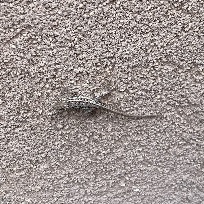Southwestern Fence Lizard (Sceloporus cowlesi)
Description: A small (up to 3 inches from snout to vent), gray-brown to golden-brown lizard with pointed, keeled, overlapping scales and two light stripes on the back. The mid-dorsum is marked with a broad, gray stripe. Some specimens have small, dark blotches on the back between the stripes. Males have two large, bright blue patches on the belly. The belly patches are usually edged with dark gray or black. The underside of the throat is marked with two blue blotches, one on each side. The shoulder area is often dark gray. Belly patches are faint or lacking in females. Gravid females often have an orange or yellow tint on the back.
Habitat: Habitat in most areas consists of openly wooded, shrubby, or rocky areas. Usually these lizards are in open/sunny situations.
Range: the range of Sceloporus cowlesi includes southern and eastern Arizona, New Mexico, western Texas, and northern Chihuahua, Mexico.
Found in these States:
AZ |
NM |
TX
Diet: The Southwestern Fence Lizard sits and waits for prey to wander within close proximity. It feeds on a variety of insects including termites, ants, beetles, grasshoppers, flies, larvae, and wasps. It also eats a variety of spiders, snails, and small lizards.
Reproduction: Mating begins in spring and continues into early summer. One to 4 clutches of eggs are laid in late spring and summer. Clutch size ranges from 1 to 10 eggs. Hatchlings begin to emerge in June and continue to emerge through September.
Status: Listed as Least Concern in view of the large and relatively stable extent of occurrence, area of occupancy, number of subpopulations, and population size. A split of this species into multiple species has been proposed, but further study is needed to clarify the geographic and taxonomic scope of the new species. Adopting such a split likely would not result in any species that are not Least Concern. Said split occured 10-01-2012
Taxonomy: Originally described in 1956 as Sceloporus undulatus cowlesi, a subspecies of the eastern fence lizard, subsequent DNA studies elevated the southwestern fence lizard to species status.
»» Kingdom: Animalia - Animals
»» Phylum: Chordata - Chordates
»» Subphylum: Vertebrata - Vertebrates
»» Class: Reptilia - Reptiles
»» Order: Squamata - Lizards
»» Family: Phrynosomatidae - North American Spiny Lizards
»» Genus: Sceloporus
»» Species: Sceloporus cowlesi - Southwestern Fence Lizard
»» Subspecies: None
This article uses material from the Wikipedia article "Southwestern Fence Lizard", which is released under the Creative Commons Attribution-Share-Alike License 3.0. Content may have been omitted from the original, but no content has been changed or extended.
|








